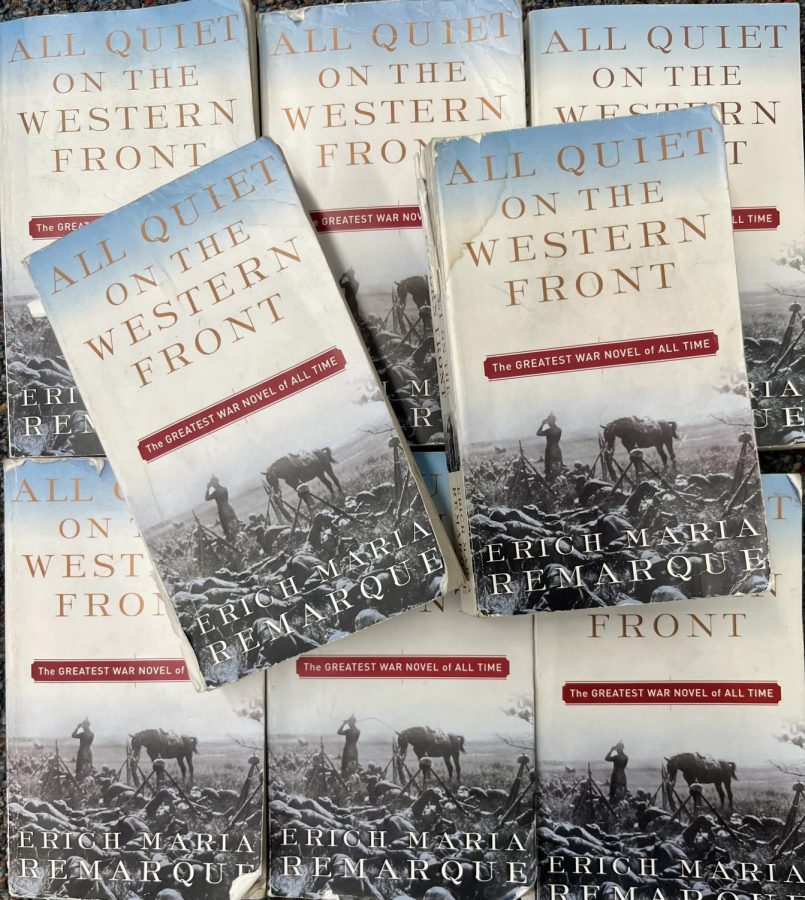REVIEW: ‘All Quiet on the Western Front’ is a powerful movie that captures the horrors of war
“All Quiet on the Western Front” is a 1928 novel written by a German WWI veteran. It’s part of the sophomore English curriculum and was turned into an award-winning Netflix movie last year.
May 4, 2023
“All Quiet on the Western Front” was released on Netflix in October 2022, and it won four Academy Awards and eight BAFTA awards. Based on the classic novel that’s a staple of many English curriculums, the German film chronicles young men who slowly experience the horrors of WWI.
Author Erich Maria Remarque was a German veteran of WWI, and his 1928 book focuses on the evolution of characters as they gradually change from upbeat teenagers into horror-filled ghosts of their former selves.
For my review, I decided to evaluate the film in three different categories: Cinematography, acting, and viewer impact
Cinematography
The lighting and camera work throughout the movie reflect the grim realities of war and the dark, gloomy atmosphere on the Western Front. The movie begins when the main character, 17-year-old Paul Bäumer, and his friends arrive at their school to receive their enlistment papers. They’re excited and energetic, and the bright lighting matches their mood.
However, as the movie progresses and the scenes become more violent, the skies and color get darker. Mixed with the camera shots that highlight just how worn out the men are with deep bags under their eyes, the cinematography gives off the aura of death and helps the viewers feel the war as if they were in the trenches, too.
Acting
Felix Kammerer, who plays the main character, Paul, was able to portray all of the emotions you’d imagine someone in WWI to go through, and he acted with such authenticity that the viewer at times feels as though they, too, were experiencing the horrors of a war.
Kammerer was effective as a naive and excited teenager at the beginning of “All Quiet,” as were his friends who peer pressured him into enlisting. As the movie progressed and the plot and cinematography darkened, so too did Kammerer. At times I felt like I was in a live WWI video game because of how great the acting was.
Viewer Impact
The movie begins with an unnamed man charging out of the bunkers and dying on the battlefield. From there it shows the absurd process of harvesting the bodies, stripping their clothes, burying the dead men, then cleaning and sewing the old uniforms to pass on to new recruits. This sets the tone for the powerful scenes the audience is about to experience.
There are three scenes in particular that impacted me the most. The first is when they get their uniforms after enlisting. Paul excitedly receives his, but then turns around with a confused look on his face; there is someone else’s name tag on it. The commanding officer claims that it was probably given to someone else and it didn’t fit him. He rips the name tag off and throws it on the ground where there is a pile of other name tags. This scene ties back to the opening scene where young men died in uniforms that are being passed on to the next group of recruits.
The next scene that affected me is just a few minutes later. After arriving at their first checkpoint on the battlefield where they see a doctor scrambling for supplies and multiple dead bodies lying on the ground, the grim reality begins to set in as they spend their first night in the bunkers. The evening is full of rain and constant bombardment, and the movie turns dark as the violence picks up. The boys start to realize that reality doesn’t at all match what they had envisioned earlier in the day.
A friend of Paul’s scrambles into the bunker for safety, but he starts to lose his mind. He cries about wanting to go home, screams for help, and shows just how young and poorly prepared he was for the brutal environment. Paul sits there in complete shock as he witnesses his school friend losing all of his sanity.
Then, the bunker is blown up and the screen goes black. Paul wakes up under rubble and realizes he survived, but he gets zero sympathy from anyone as people are barking orders at him. The moment he shows he’s alive, a soldier yells at him to collect the dog tags of the dead bodies, including one face down in the mud who turns out to be his friend, the one he was sitting next to just a few seconds ago.
The movie fast forwards to 18 months later, and the men steal a goose out of desperation for any sort of decent nutrition. As they begin to eat it, Paul and the others laugh and smile, revealing their dark yellow and rotting teeth, once again capturing the true effects of war.
The third scene that impacted me is one of the final moments in the movie. The Germans are only a few hours away from surrendering, but the soldiers are told to prepare for one final push. Everyone is terrified and extremely irritated because they had survived the war and now have to fight one last time knowing people are going to die for absolutely no reason at all.
Moments before the trumpet sounds to signify the end of the battle, Paul walks out of a bunker and stands in shock as he faces his enemy, a French soldier. The soldier stares at Paul for a second, then attacks him with his bayonet. Right as Paul’s limp body falls into the mud, the final trumpet goes off and the war is over.
The screen pans out from his body, then shifts to a young soldier who is clearly a new recruit. One of the officers yells at the kid and tells him to pick up the dog tags of the dead bodies, just like Paul did when he first arrives at the front.
This scene impacted me a lot because it showed the soldiers’ circle of life. The German army didn’t really care if someone died because there will always be another person to fill that position. Humans were nothing more than disposable objects in WWI.
The movie had an extreme impact on me and others I’ve talked to who have seen it. Every aspect of “All Quiet” kept the viewer engaged and focused, and there weren’t any boring scenes. Even in the scenes where the political leaders are talking about ceasing fire, I was able to pay attention. The actors, director, and producers made sure every detail was perfect, and their hard work shows throughout the movie.
Conclusion
With all points listed, I think this movie is a masterpiece. This may sound extremely over the top, however, I truly mean it. The movie is pretty long, clocking in at 2 hours and 23 minutes, but there wasn’t one time when I was bored, looking at my phone, or tempted to skip forward a little bit. I will admit that I’m a history nerd, but I think even non-history buffs will find this movie entertaining and impactful.





